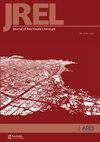The Housing Boom and Bust
Q3 Social Sciences
引用次数: 33
Abstract
The Housing Boom and Bust. Thomas Sowell. 184 pages, New York: Basic Books, 2009. Virtually from the onset of the U.S. housing market's precipitous price decline in 2006-07, academicians, politicians, and the media have sought to explain how the housing bubble that set the stage for the debacle developed and grew to such dangerous proportions. Not all observers were caught off-guard by the bubble. As early as 2003, for example, The Economist cautioned against the risk of expecting continued housing price escalation or, worse yet, the "risk that house prices will take such a tumble that they take whole economies with them." Again, in 2005, the same publication observed that "the day of reckoning is closer at hand," and "it is not going to be pretty." When it finally arrived, the housing market's "day of reckoning" was ugly indeed, bringing with it bruising housing price declines, unprecedented foreclosure rates and, in a follow-on effect, a crisis on Wall Street in which institutions and investors realized that the default risk embedded in widely traded mortgage-based financial instruments had been grossly mispriced. Whether or not one foresaw it, the core question remains: What actually caused the housing boom (and bust)? Equally important, how might a similar crisis be averted in the future? These are the questions that Thomas Sowell, Rose and Milton Friedman Senior Fellow at the Hoover Institution, addresses in his highly readable and informative book The Housing Boom and Bust. From the outset of the book-totaling a compact 148 pages, excluding 29 pages of source material at the end-Dr. Sowell qualifies that "there was no single cause of the housing crisis, and there is certainly plenty of blame to go around." Readers, of course, will be acquainted with oft-cited explanations for the fiasco, including: the Federal Reserve nurtured a bubble with low interest rates over an extended period of time; lenders offered exotic loan products that simultaneously confused less knowledgeable participants and enhanced the ability of sophisticated speculators to buy and re-sell homes without using their own cash; a lack of serious regulatory oversight enabled lenders to ignore reasonable standards of lending (i.e., those consistent with actual borrower creditworthiness) and make loans based upon inaccurate or incomplete applicant information (e.g., "low-doc" and "no-doc" loans); the credit rating agencies (e.g., Moody's) failed to accurately assess risk inherent in subprime mortgages; and so on. In Sowell's account, borrowers, lenders, government, and financial markets were each responsible for the crisis. As he succinctly puts it, "All were responsible and many were irresponsible." However, the central premise of the book is that responsibility among these players was not shared equally. The chief culprit, by far, was government, both local and federal, in the form of ill-advised interventions (or interference). Writing in language accessible to both expert and layperson alike, and providing extensive documentation to support his case, Sowell lays out a simple causal sequence of what happened: The U.S. housing price boom originated in (and was largely limited to) specific geographic places, such as coastal California and Miami, as land became increasingly expensive. Land price escalation occurred in these places not because of abnormally high construction costs or income growth rates, but rather because, he argues, governmental entities imposed land use restrictions in the name of protecting open space, preserving farmland, preventing urban sprawl, and similar justifications. These restrictions made it either impossible or much more expensive than would otherwise have been the case to build upon land. As the price of land shot up, so did overall housing prices. Having created a "housing affordability" problem as a result of restricting land use, government compounded the problem by enabling increasingly risky borrower financing. …房地产繁荣与萧条
房地产繁荣与萧条。托马斯·索威尔著,184页,纽约:Basic Books出版社,2009年。实际上,从2006-07年美国房地产市场价格急剧下跌开始,学者、政治家和媒体就一直试图解释房地产泡沫是如何为崩溃奠定基础的,并发展到如此危险的程度。并非所有观察人士都对泡沫猝不及防。例如,早在2003年,《经济学人》就警告过房价持续上涨的风险,或者更糟的是,“房价暴跌会拖累整个经济的风险”。2005年,同一份出版物再次指出,“清算的日子越来越近了”,而且“情况不会很好”。当它最终到来时,房地产市场的“清算日”确实是丑陋的,随之而来的是惨烈的房价下跌,前所未有的止赎率,以及随之而来的华尔街危机。在这场危机中,机构和投资者意识到,广泛交易的以抵押贷款为基础的金融工具所蕴含的违约风险被严重错误地定价了。不管人们是否预见到了这一点,核心问题仍然存在:到底是什么导致了房地产的繁荣(和萧条)?同样重要的是,未来如何避免类似的危机?这些都是胡佛研究所(Hoover Institution)罗斯和米尔顿·弗里德曼高级研究员托马斯·索威尔(Thomas Sowell)在其可读性强、信息量大的著作《房地产繁荣与萧条》(the Housing Boom and Bust)中提出的问题。这本书总共有148页,不包括结尾29页的原始资料。Sowell认为“房市危机并不是单一原因造成的,而且肯定有很多责任可以推卸。”当然,读者们会熟悉对这次惨败经常被引用的解释,包括:美联储在很长一段时间内以低利率孕育了泡沫;贷款机构提供了一些奇特的贷款产品,这些产品既迷惑了不太懂行的参与者,又增强了老练的投机者在不动用自有资金的情况下买卖房屋的能力;由于缺乏严格的监管,贷款人可以忽视合理的贷款标准(即与借款人实际信誉相符的标准),并根据不准确或不完整的申请人信息(例如,“低文件”和“无文件”贷款)发放贷款;信用评级机构(如穆迪)未能准确评估次级抵押贷款的内在风险;等等......在索厄尔的描述中,借款人、贷款人、政府和金融市场都对这场危机负有责任。正如他简洁地指出的那样,“所有人都有责任,许多人不负责任。”然而,这本书的中心前提是,这些参与者之间的责任并不是平等分担的。到目前为止,罪魁祸首是地方和联邦政府,他们采取了不明智的干预(或干涉)。索威尔用专家和外行都能理解的语言写作,并提供了大量的文件来支持他的观点,他列出了发生的事情的简单因果顺序:随着土地变得越来越昂贵,美国房价的繁荣起源于(而且很大程度上限于)特定的地理位置,比如加利福尼亚沿海和迈阿密。他认为,这些地方的地价上涨并不是因为过高的建设成本或收入增长率,而是因为政府实体以保护开放空间、保护农田、防止城市扩张和类似理由的名义实施了土地使用限制。这些限制使得在陆地上建造房屋要么不可能,要么要比在陆地上建造房屋昂贵得多。随着土地价格的飙升,整体房价也在上涨。由于限制土地使用而造成了“住房负担能力”问题,政府允许风险越来越大的借款人融资,使问题更加复杂。…
本文章由计算机程序翻译,如有差异,请以英文原文为准。
求助全文
约1分钟内获得全文
求助全文
来源期刊

Journal of Real Estate Literature
Economics, Econometrics and Finance-Economics, Econometrics and Finance (miscellaneous)
CiteScore
0.90
自引率
0.00%
发文量
6
期刊介绍:
The Journal of Real Estate Literature (JREL) is a publication of the American Real Estate Society (ARES). This journal offers a comprehensive source of information about real estate research and encourages research and education in industry and academia. The scope of the journal goes beyond that of traditional literature journals that only list published research. This journal also includes working papers, dissertations, book reviews and articles on literature reviews on specialized topics, real estate information technology and international real estate.
 求助内容:
求助内容: 应助结果提醒方式:
应助结果提醒方式:


